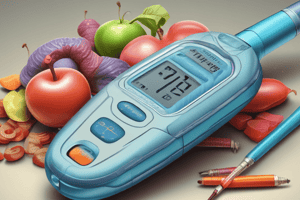Podcast
Questions and Answers
What is the most likely cause of the patient's blurry vision?
What is the most likely cause of the patient's blurry vision?
- Diabetic retinopathy due to prolonged hyperglycemia (correct)
- Cataracts forming from prolonged insulin use
- Hypertension causing optic nerve damage
- Chronic kidney disease related to diabetes
What does a glycosylated hemoglobin level of 9.1% indicate for this patient?
What does a glycosylated hemoglobin level of 9.1% indicate for this patient?
- Effective use of oral hypoglycemics
- Good diabetes control
- Possible insulinoma
- Poor diabetes control (correct)
Which of the following laboratory findings indicates the presence of diabetic nephropathy?
Which of the following laboratory findings indicates the presence of diabetic nephropathy?
- Serum creatinine of 1.8 mg/dL
- Estimated glomerular filtration rate of 45 mL/min/m2
- Urine albumin-to-creatinine ratio of 460 mg/g (correct)
- Total cholesterol of 225 mg/dL
Considering this patient's current medication regimen, which medication does not directly address her diabetes management?
Considering this patient's current medication regimen, which medication does not directly address her diabetes management?
What could be a potential complication of the patient's insulin therapy if blood glucose levels fluctuate?
What could be a potential complication of the patient's insulin therapy if blood glucose levels fluctuate?
Flashcards are hidden until you start studying
Study Notes
Patient Profile
- 46-year-old female with a 22-year history of type 1 diabetes mellitus.
- Managed with both long-acting and rapid-acting insulin therapies.
Insulin Therapy
- Current insulin regimen: Insulin detemir (long-acting) and insulin lispro (rapid-acting).
- Reports fluctuations in blood glucose levels and episodes of hypoglycemia despite insulin adjustments.
Vision Changes
- Experiencing slight blurriness in vision over the past 6 months, indicative of potential diabetic complications.
Vital Signs
- Blood pressure: 145/85 mm/Hg, which is above normal range, indicating possible hypertension.
- Pulse rate: 78 beats per minute, normal resting rate.
- Oxygen saturation: 99% on room air, indicating adequate oxygen levels.
Laboratory Findings
- Glycosylated hemoglobin (HbA1c): 9.1%, suggesting poor long-term glycemic control.
- Serum creatinine: 1.8 mg/dL, indicating possible renal impairment.
- Estimated glomerular filtration rate (eGFR): 45 mL/min/m², confirming chronic kidney disease.
- Urine albumin-to-creatinine ratio: 460 mg/g, highlighting significant proteinuria as a complication of diabetes.
- Total cholesterol: 225 mg/dL, slightly elevated and could contribute to cardiovascular risk.
Current Medications
- Insulin therapy (detemir and lispro) for diabetes management.
- Atorvastatin included for cholesterol management.
Summary of Conditions
- Patient presents with complications of diabetes: poor glycemic control, renal impairment, and potential diabetic eye disease.
- Requires comprehensive management including insulin adjustments, monitoring for cardiovascular risk, and addressing diabetes-related complications.
Studying That Suits You
Use AI to generate personalized quizzes and flashcards to suit your learning preferences.




